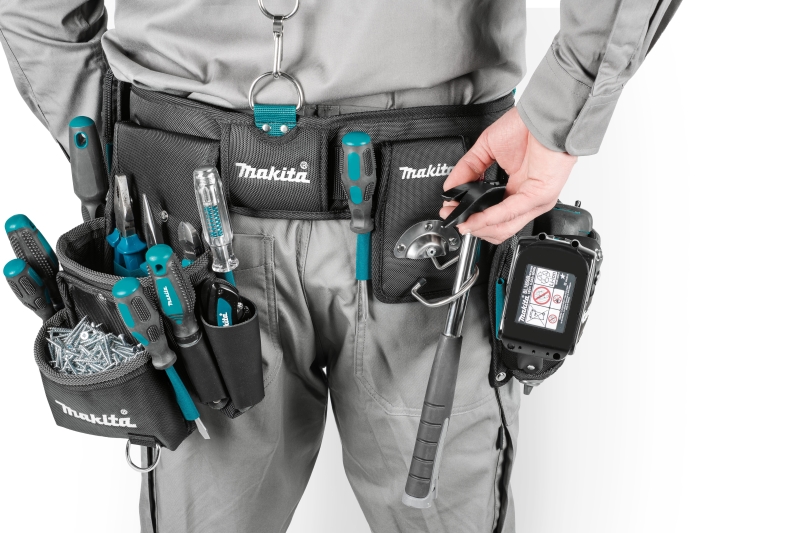
 In the next part of our buyers guide series for tools and equipment, Makita offers some advice on choosing the right tool belt and storage systems to safely carry the tools you need and ensure they are always to hand.
In the next part of our buyers guide series for tools and equipment, Makita offers some advice on choosing the right tool belt and storage systems to safely carry the tools you need and ensure they are always to hand.
Having easy access to the tools, fixings and other items required for the job can help reduce the frustration of misplaced items and improve productivity by minimising the wasted time of repeatedly going back to the tool kit. Tool belt and storage systems allow professionals to have everything in easy reach. Generally, these will consist of a belt, usually designed for the purpose, with holsters, pouches, hooks, loops and holders attached for the storage of power tools and hand tools, fixings, pencils, measuring tapes, parts, screwdriver bits, adaptors and other materials.

However, there are a wide range of options on the market with different types, constructions and materials available, so it is not always simple to work out which one is most suitable. When choosing a system, there are a few key factors that professionals should keep in mind.
A modular system
Often the most versatile products will be systems where a wide variety of individual elements can be added and positioned on the belt, according to the needs and preferences of the user. For instance, some professionals may want to keep a drill or driver within reach at all times, some need hammers and chisels close to hand, whilst others may require quick and easy access to nails and screws. Some may want all of these and more. Also, the needs of different jobs could mean that it is valuable to be able to easily customise what is being carried.

When selecting a system, it is important to look at the variety of pouches and holders available. These can include multipurpose options or those made for particular items, such as spare tool batteries and tape measures, as well as ones designed for specific trades. For example, the Makita range has a wide array of elements that can be added to their belt system, and in particular, pouches made for roofing, electrical and grounds maintenance work.
Comfort and ease of use
As the tool belt will likely be used all day, every day, one of the most important things to consider is the comfort. It is particularly important to look at the construction of the belt itself. It should be designed to effectively distribute the weight around the wearer’s body and should ideally have the option to connect braces or a harness to spread the weight of the tools further to prevent fatigue and discomfort. Also, the material should provide cushioning but also allow air-flow to be comfortable at all times of the year.

Additionally, it is worth looking at the apparently small features that can make the belt system easier to use and help to streamline work. This may be pouches that are designed to swing so they remain vertical as the wearer moves to prevent fixings spilling out. Also, hinged ‘side gate’ mechanisms on holders for hammers or similar, mean the tool can be easily clipped into the holder without the need to look down.
Durability
While it may sound obvious, it is important to ensure that the tool belt system is robust enough to withstand how it will be used. The exterior of the pouches and holders needs to be hardwearing as they are exposed to the wear and tear typical on a job site. Woven polyester is ideal for this as it resists scuffs and scrapes to stop the belt and pouches from quickly looking worn. The durability of the individual sections, loops and holders should also be considered. Sharp edges and the points of tools such as screwdrivers and chisels can damage the holders. That is why it is worth looking for products that are lined with a tough material that is suitable for this. The Makita tool belt system, which is primarily manufactured from polyester textile, features leather in key areas inside the pouches to prevent damage.

Versatility
Another factor that should be considered is how the individual parts can be used. For some jobs it may not be necessary, or even desirable, to use a full tool belt and it may be easier to use one or two of pouches separately. There are options available that will connect to a standard belt if required as well as enable other mounting options, such as attachment to workwear pockets. Additionally, some of the larger pouches in the Makita range can be used independently if required, as they are shaped to allow them to stand upright and feature integrated carry handles if you don’t want to attach them to a tool belt system. The range also includes storage solutions such as guide rail holders, lunch bags, tool bags, tool boxes, tote carriers and more, to offer a more traditional means for organising tools whilst on the job.
Tool belt systems can offer a simple way to keep tools and other items within easy reach to minimise wasted time, make work easier and ultimately streamline the completion of tasks. Investing in the right system is important, especially when it comes to everyday comfort and convenience.
To find out more about the Makita tool belt system range visit Homepage (makitauk.com) or go to Pouches and Holders (makitauk.com).







